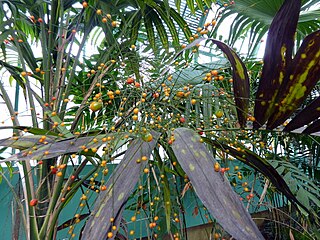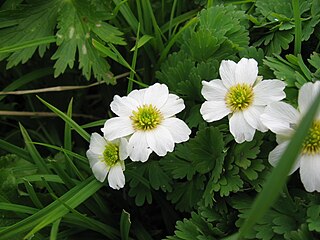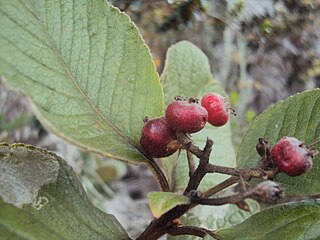Related Research Articles
Python is an interpreted, high-level and general-purpose programming language. Python's design philosophy emphasizes code readability with its notable use of significant whitespace. Its language constructs and object-oriented approach aim to help programmers write clear, logical code for small and large-scale projects.

Vaccinium is a common and widespread genus of shrubs or dwarf shrubs in the heath family (Ericaceae). The fruits of many species are eaten by humans and some are of commercial importance, including the cranberry, blueberry, bilberry (whortleberry), lingonberry (cowberry), and huckleberry. Like many other ericaceous plants, they are generally restricted to acidic soils.

The Rutaceae are a family, commonly known as the rue or citrus family, of flowering plants, usually placed in the order Sapindales.

A digital object identifier (DOI) is a persistent identifier or handle used to identify objects uniquely, standardized by the International Organization for Standardization (ISO). An implementation of the Handle System, DOIs are in wide use mainly to identify academic, professional, and government information, such as journal articles, research reports, data sets, and official publications. However, they also have been used to identify other types of information resources, such as commercial videos.

Laccospadix is a monotypic genus of flowering plant in the palm endemic to Queensland. Only one species is known, Laccospadix australasicus, commonly called Atherton palm or Queensland kentia. The two Greek words from which it is named translate to "reservoir" and "spadix".
Lepidocaryum is a monotypic genus of flowering plant in the palm family from South America where the lone species, Lepidocaryum tenue, is commonly called poktamui. Nine species names have been published but palm taxonomists agree that just one variable species includes them all. The most reduced member of the Lepidocaryeae, it is similar in appearance to three closely related genera, Mauritia, Mauritiella, and Lytocaryum. The genus name combines the Greek words for "scale" and "nut" and the species epithet is Latin for "thin".

Synechanthus is a monoecious genus of flowering plant in the palm family found in Mexico, Central and South America. Commonly called bola, palmilla, or jelly bean palm, they are closely related to members of Chamaedorea, only distinguished by their flower and fruit form. The Greek genus name is a combination of "united" and "flower".
Pygeum is a genus consisting of tropical trees or shrubs limited to tropical Africa, South & South-east Asia, Northeastern Australia, New Guinea and some Pacific Islands.
Viettessa is a genus of moths of the family Crambidae.

Clytostoma was a genus of woody-stemmed vines from tropical America, native to Argentina and the southern part of Brazil. It is now considered a synonym of Bignonia. The botanical name comes from the Greek, klytos means splendid or beauteous, and stoma means mouth; alluding to the beautiful flowers. It is closely related to Bignonia, from which it differs chiefly in its simple slender tendrils, the short disk, and that it has a habit of clambering over adjacent foliage using tendrils to hang on tight. The bright glossy green leaves are lobed and divided with 2 leaflets, about 3in (7.6 cm) long and 1.5in (3.8 cm) wide. They are arranged opposite in pairs and tendrils arise at the ends of the leaf stalks. In late spring, the spectacular 1.5in (3.8 cm) trumpet flowers are borne terminally or along the branches. The flowers are pale lavender and delicately detailed with dark violet and purple veins. Flowers are followed by large prickly seed pods. This evergreen ornamental plant easily reaches to 16 feet and is a carefree grower. It has only recently been moved out of the genus Pandorea.

Callianthemum is a genus that consists of 24 species of little rhizomatous herbs from high mountains in Europe, Central Asia and East Asia. The botanical name comes from the Greek, which means beautiful flower. The plants are low-growing, ornamental perennials and are lovely to rock garden. Leaves are small and radical. Flowers are showy daisy-like, 1.5in in diameter, with 5-15 white or rose-color petals and nectaries at the base. Blooming in spring.

Hesperomeles is a genus of South American evergreen trees of the family Rosaceae that has sometimes been included along with Pyracantha in the genus Osteomeles. However, Osteomeles notably have compound leaves, and recent molecular phylogenetics suggests that Hesperomeles is only distantly related to Osteomeles, and is instead sister to the Crataegus—Mespilus clade.
A botanical expedition is a scientific journey or voyage designed to explore the flora of a particular region. The expedition could be specifically designed for exploring the flora, or this could have been a part of studying the natural history of the region. A naturalist or botanist was charged with drawing and describing the flora, collecting specimens of unknown plants in a plant press, and identifying potential economically important plants. On botanical expeditions funded by governments, the plants were often collected by the person in the field, but described and named by a government sponsored scientists at botanical gardens and universities. For example, many of the species collected on the Lewis and Clark Expedition were described and named by Frederick Traugott Pursh.
Viettessa villiersi is a moth in the family Crambidae. It was described by Hubert Marion in 1957. It is found in Benin.

Machairophyllum latifolium is a member of the family Aizoaceae, and is native to South Africa.
Curcuma zedoaroides A. Chaveerach & T. Tanee is locally named in Thai as Wan-Paya-Ngoo-Tua-Mia. It was firstly described by Chaveerach et al., 2008. This plant is cultivated in the king cobra village of Khon Kaen Province, Northeastern Thailand, where it is commonly used for snake-bite antidote. Lattmann et al. (2010) and Salama et al. (2012) have been published the Antivenom activity of some phytochemical compounds isolated from plant rhizomes extract against Ophiophagus hannah.
Dioscorea bernoulliana is a type of yam in the family Dioscoreaceae. It is native to Belize, Guatemala, Honduras, and Mexico. It usually grows in woodlands, forests, and mangrove swamps.
Argyrochosma delicatula is a fern known from northeastern Mexico. It grows in rocky habitats, either in sun or in shade, and is distinguished from similar species by the presence of pale yellow powder on the underside of its leaves. First described as a species in 1939, it was transferred to the new genus Argyrochosma in 1987, recognizing their distinctness from the "cloak ferns".